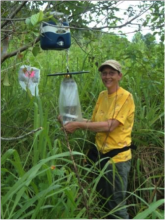You are here
Project 11.2 Improved approaches for detection of disease and prevention of spread in Torres Strait

Emerging infectious diseases are on the rise with future outbreaks predicted to occur in frontier regions of tropical countries. Disease surveillance in these hotspots is challenging because sampling techniques often rely on vector-attractants that are either unavailable in remote localities or difficult to transport.
Globally, the standard attractant used to capture disease vectors such as mosquitoes is CO2 , which is normally supplied from CO2 gas canisters or dry ice, both of which are unavailable in remote regions without great expense.
We examined via laboratory and field trials, if a novel method for producing CO2 from yeast and sugar would be an appropriate alternative to dry ice. Across three different vegetation communities, we found traps baited with dry ice frequently captured more mosquitoes than yeast-baited traps, however there was little difference on mosquito community composition. That means that although we may not catch as many mosquitoes as the standard attractant, we are able to catch the same species which is the more important issue. If there are Anopheles or Aedes mosquitoes (both important vectors of human diseases) at the site then our novel method will work as well as the standard technique.
Based on our preliminary experiments, we find that this novel method of producing CO2 is a realistic alternative to dry ice that would be highly suitable for remote field work. During the wet season next year we will be trialling our novel attractant alongside a new passive mosquito trap design that Professor Scott Ritchie has been developing. Our objective is to develop a sampling method that can be undertaken in any remote region in the world by any person, in the hope that we can be ready for the early detection of future disease outbreaks.
Find out more about the project here
Image: Dagmar Meyer Steiger and a standard Centre for Disease Control trap with dry ice. Photo by Dr Susan Laurance
Latest News
- Laws protecting the Great Barrier Reef to be introduced next week, Queensland Premier says - Thu 28th May 2015
- Let’s get serious about protecting wildlife in a warming world - Thu 28th May 2015
- We’ve only monitored a fraction of the Barrier Reef’s species - Thu 28th May 2015
- Great Barrier Reef: warmer waters helping coral-eating starfish thrive - Fri 13th Feb 2015
- You are what you eat—if you're a coral reef fish - Wed 17th Dec 2014


